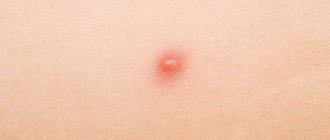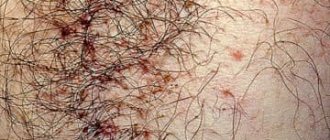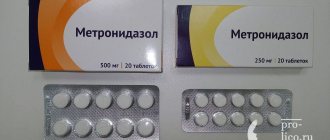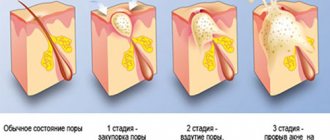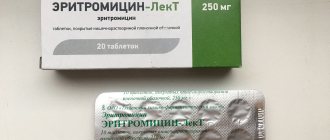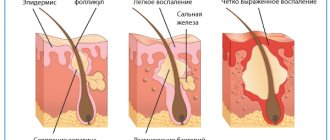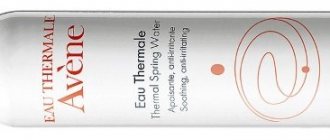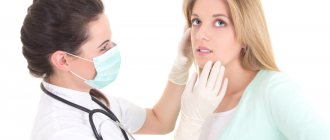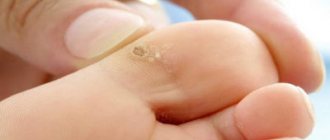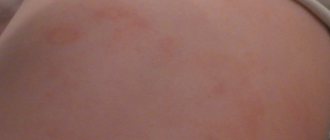Nodulocystic acne or nodulocystic acne is a form of acne that most often occurs in adolescents. It can develop on any part of the body, but most often appears on the face. This form of acne looks like deep infiltrates or cavities, inside of which there is a large amount of pus. After opening such an abscess, a scarring process occurs, and a rough scar remains on the skin.
Treatment consists of using antibiotics, both locally and for oral administration, and products with zinc and azelaic acid are also used. Treatment can be supplemented with mesotherapy, ozone therapy, cryotherapy and other methods that will be recommended by dermatologists.
Causes of cystic acne
The cause of the development of cystic acne is the overactive work of the sebaceous glands. The sebum they produce clogs the ducts and leads to the development of an inflammatory process against the background of the active proliferation of pathogenic bacteria. The following factors contribute to an increase in the production of sebaceous secretion by the glands:
- seborrheic dermatitis;
- hormonal changes;
- poor nutrition;
- alcohol abuse;
- taking hormonal drugs.
Seborrheic dermatitis is one of the main causes of severe acne. Dermatological pathology is accompanied by an increase in sebum secretion and a change in the quality of sebum. The pathological process is provoked by the yeast-like lipophilic fungi Pityrosporum ovale. In this case, cystic acne is a complication of seborrheic dermatitis, which requires separate therapy.
Hormonal changes are typical during puberty, pregnancy, as well as with pathologies associated with the adrenal glands and ovaries. Changes in the hormonal background lead to active work of the sebaceous glands. That is why cystic acne is most often observed during this period.
Frequent consumption of alcohol, sweet carbonated drinks, confectionery, chips, smoked foods, fried and fatty foods inevitably leads not only to intense sebum production, but also to a decrease in immunity. As a result, the skin becomes unable to independently fight the proliferation of pathogenic microorganisms, which cause severe acne.
Hormonal medications, which include oral contraceptives, insulin-based medications and inhibitors, also cause malfunction of the sebaceous glands and can lead to the development of dermatological diseases.
Treatment of inflammation on the face
After conducting all the necessary tests and making a diagnosis, the doctor will prescribe effective treatment.
The main methods for getting rid of cystic acne include:
- Local exposure using hardware cosmetology equipment.
- Ultraviolet therapy.
- Application of a medicinal line of pharmaceutical cosmetics.
- Therapeutic diet.
- Internal use of retinoic spectrum drugs or a course of antibiotics.
The course of treatment ranges from several weeks to a year (in especially severe cases, a longer duration is possible) and depends on the severity of the disease and the individual condition of the body. It is necessary to carefully follow all the doctor’s recommendations and the result will not be long in coming.
Using hardware
Modern cosmetic procedures can quickly tidy up even the most neglected skin.
There are several proven methods that give positive results.
- A cosmetic laser can not only renew and rejuvenate the skin, but also get rid of purulent rashes. The impact can be carried out both locally, only on inflammatory elements, and throughout the skin. There are contraindications, one of which is rosacea. It is better to consult your doctor for more details.
- Mesotherapy and biorevitalization. Therapeutic cocktails, injected under the skin with injections, saturate it with useful components, vitamins and increase resistance to infectious acne. The procedure is done in a course, on average from three to ten visits. They can be done even in adolescence.
- Phototherapy helps speed up the healing of existing cystic inflammation and avoid scar formation.
- Darsonval accelerates the exfoliation of dead skin particles, improves the functioning of the sebaceous glands and gives good results in combination with therapy.
Ultraviolet therapy
Very often, doctors recommend visiting a solarium for patients with problem skin. The main thing is that the dose of ultraviolet radiation does not exceed the permissible limits.
Products for external use
In the treatment of cystic acne, there are several groups of drugs based on different active ingredients:
- Vitamin A derivatives, retinols and retinoids. At the moment, retinol-based products are considered the most effective in the fight for perfect skin. The degree of impact depends on the percentage of the active substance and is prescribed individually. Typically, 0.025% retinol is used at the beginning of treatment. There is increased exfoliation of skin cells, active renewal, pigment spots are smoothed out and gradually disappear. The product has contraindications and is unacceptable during pregnancy and lactation.
- Benzoyl peroxide. Normalizes the functioning of the sebaceous glands, prevents their derivatives from clogging pores, dries out existing pimples and prevents the formation of new ones.
- Glycolic, lactic, azelaic and salicylic acids. Cosmetic acids have long been helpful in the fight for clear skin. They are present in almost all pharmaceutical cosmetics. Which one to choose and in what concentration is best left to the doctor.
Therapeutic diet
When it is recommended to change your diet, the first foods that will be prohibited are:
- Canned food.
- Any fast food.
- Smoked meats and marinades.
- Foods with a lot of salt.
- Chips, crackers.
- Fatty meat broths.
- Fatty and fried meat.
- Sweets (except dark chocolate).
- Carbonated drinks.
- Alcoholic drinks.
For better functioning of the gastrointestinal tract, you should include more vegetables and fruits that contain fiber in your diet. Be sure to drink at least one and a half liters of clean water a day, because water removes toxins from the body.
Internal
In severe stages of the disease, the doctor may prescribe a course of treatment with antibiotics or drugs with retinoids.
These drugs accumulate in the skin over time and destroy the pathogenic bacteria P. Acnes, which, in turn, stops the formation of purulent cysts. Visible results of these drugs are observed after two weeks of use.
Clinical picture of cystic acne
The overactive work of the sebaceous glands, which results in the formation of a thick secretion, causes difficulty in outflow through the excretory ducts. Sebum accumulated in the ducts of the glands is a favorable environment for the development and reproduction of pathogenic microorganisms. The skin becomes infected, resulting in an inflammatory process. In severe acne, inflammation affects both the superficial and deep layers of the epidermis. As a result, such a pathological process leads to the appearance of fibrous scar formations.
The most common location for cystic acne is the skin of the face, chest and back. In the affected areas, there is enlargement of the pores, severe redness that extends beyond the sebaceous glands, as well as fibrous nodular growths. As the skin lesions mature, cysts form, which are subsequently filled with pus. The affected areas become dark red with a bluish tint. Fibrous purulent growths bring not only aesthetic discomfort, but also cause pain.
The formation of fibrous scar elements during the post-acne period occurs due to the replacement of the affected epidermal cells with dense connective tissue.
In the presented photos you can see a typical clinical picture characteristic of cystic acne.
Traditional treatment
Since the formation of inflamed cysts affects the deep layers of the dermis, the spread of the process can lead to serious damage to the skin. Timely treatment can prevent the appearance of unsightly scars. There is a traditional therapeutic regimen.
It must include:
- Benzoyl peroxide is the most popular antiseptic. It has been used for 50 years to treat any form of acne. Its mechanism of action is aimed at destroying the bacterium Propionibacterium acnes. This occurs due to the destruction of the walls of the pathogenic microorganism with the help of reactive oxygen species formed on the surface of the skin after applying the local form of the drug. In addition, the chemical formula of the product dissolves horny scales, thereby enhancing the therapeutic effect by eliminating peeling of the skin. However, benzoyl peroxide does not affect the synthesis of sebum. The drug is available in the form of a gel of varying concentrations and in the form of a lotion. Low concentrations (2.5% and 5%) are used to treat acne on the face, high concentrations (10%) are used to treat acne on the back. The trade name of the product is “Baziron AS”, “Ugresol”, “Proactive”. The drug is used for the external treatment of acne, applied to the affected areas with a thin layer twice a day - morning and evening.
- Systemic treatment with retinoids (Roaccutane, Retasol, Verocutan). Patients are prescribed to take tablets orally at a dose of one milligram per kilogram of body weight. You need to drink once a day for twenty weeks. The effect of vitamin A on cells is similar to the effect of corticosteroid drugs: the inflammatory reaction is suppressed, leukocyte infiltration is reduced.
- Antibiotics. They are prescribed in the form of ointments intended for local treatment (Clindamycin, Erythromycin) and in the form of tablets for internal use (Tetracycline and its derivatives). Such drugs reduce the number of bacteria and relieve inflammation. Their effectiveness is enhanced if antibiotics are taken in parallel with the drugs described above.
- Birth control pills. Prescribed mainly for the treatment of nodular cystic acne in girls. The course of treatment is six months. Estrogen and progesterone included in contraceptives suppress sebum production.
- Injections of steroid drugs. Prescribed if the patient experiences scar formation after acne has healed. Such treatment can only be carried out under the supervision of a dermatologist. After the injection, local side effects may appear, but they are short-term and therefore pass quickly.
If there are large cysts, the doctor may suggest an incision and drainage of the inflamed area. You cannot carry out such a procedure yourself: any incorrect action will lead to the development of a deep infection and the appearance of unsightly scars.
Physiotherapeutic treatment
Some physiotherapy procedures are necessarily included in treatment regimens for severe forms of acne. They help enhance the effect of drug treatment. The patient is recommended to undergo laser therapy and darsonvalization. With an integrated approach, they lead to a reduction in the inflammatory process, increased local blood circulation, increased protective properties of the skin, and resorption of filters, which helps avoid the formation of scars.
If the patient sought medical help late, if the development of acne led to the appearance of noticeable scars on the face, they can be dealt with using cryomassage, laser peeling and mesotherapy. Procedures are carried out exclusively after completion of the inflammatory process.
Diet therapy
As mentioned above, the dependence of the appearance of nodular cystic acne on the consumption of any specific products has not been identified. Despite this, patients are still advised to adhere to a restrictive diet during treatment. It helps reduce the burden on the body and stop the intense production of sebum. It is useful to completely exclude from the diet:
- alcohol;
- sweets;
- flour;
- fat;
- spicy;
- pickled;
- smoked;
- fast food;
- semi-finished products with a long shelf life.
When creating a menu, it is useful to focus on plant-based protein foods and fermented milk products. The minimum duration of the diet is a month, but it is better to stick to it for six months.
Traditional medicine recipes
During treatment, it is important to take proper skin care: use foam cleansers, gels and lotions to cleanse inflamed skin. It is better to cook the latter at home. Well suited for these purposes:
- juice made from fresh aloe leaves;
- decoction of chamomile;
- infusion of calendula.
The listed agents have an antiseptic and anti-inflammatory effect, so their use will enhance the effect of drug treatment.
Differential diagnosis of skin disease
In addition to examination by a dermatologist, the diagnosis of cystic acne includes the following measures:
- dermatoscopy;
- pH-metry;
- bacteriological culture.
Dermatoscopy is a hardware method of differential diagnosis, which can be used to conduct a visual assessment of pathological processes occurring in the dermis.
The acid-base balance is determined using pH meters in the form of glass electrodes. This diagnostic method allows you to differentiate the cystic form of acne from various forms of pyoderma, which are purulent-inflammatory skin diseases.
The material for bacteriological culture is the purulent contents of cysts and epidermal scales. The results of this analysis help to identify the type of bacteria and their resistance to certain antibiotics.
How to diagnose: photo
The inflammatory process, affecting not only the surface layer, but also the dermis, is the main symptom by which the cystic form of acne is determined. The photo below clearly demonstrates the features of this type of disease and the location of acne. Usually the pathological process affects the face, back and chest.
Fibrous-scarring elements form on the skin, accompanied by redness, enlarged pores, and growths. As inflammation develops, cystic acne appears, filled with purulent contents. They look extremely unaesthetic and are painful when touched. Regression of the disease is expressed in the replacement of affected cells with connective tissue, which causes scar formation.
Diagnosis of cystic acne is carried out using the method of inspection and palpation. To clarify the diagnosis and differentiate it, blood tests, bacterial cultures, and instrumental research methods are prescribed. To select an effective treatment method, it is necessary to exclude the following pathologies:
Treatment methods for nodular cystic acne
Cystic acne includes the following therapeutic measures:
- taking antibiotics and retinoids;
- topical drugs;
- hardware method of treatment;
- nutrition correction.
Treatment of a dermatological disease begins with identifying and eliminating the cause of cystic acne. The duration of therapy can range from several months to a year or more, depending on the severity of acne.
Systemic antibiotics and retinoids
For severe acne, the following systemic antibiotics are prescribed:
- Minocycline;
- Minolexin;
- Doxycycline.
Drugs in this category are able to penetrate the fat barrier and accumulate in the area of inflamed areas. Potent antibiotics inhibit the growth of pathogenic bacteria and reduce inflammation. The duration of antibiotic therapy is from 1.5 to 2 months.
Skin problems: Acne, blackheads, comedones, blackheads
A very important event is approaching, but acne appears on your face that is not at all decorative? And your nose is covered in black spots? And the mirror in the bathroom with its treacherously wonderful lighting shows all the imperfections on the face, like on a topographical map of the world? There is an exit!
Like the law of meanness, skin that was perfect up to this point, in an instant becomes covered with imperfections. We begin frantically going through our makeup bag in search of the perfect concealer, we even try to cleanse the skin ourselves and, accordingly, we only make things worse. I think the situation is painfully familiar to everyone.
What are the differences?
Blackheads or comedones, blackheads or acne. What are their differences and, most importantly, why do they arise? In order to answer these questions, you first need to clearly understand the difference between them.
Black dots
Blackheads are clogged openings of the sebaceous glands. The mouth of the canal, in addition to the secretion of the sebaceous gland, becomes clogged with particles of horny scales and dust. In total, this creates the effect of blackheads.
Mainly in the so-called T-zone of the face: forehead-nose-chin, since sebum production is higher here and the pores are wider.
They are usually small in size and, when the pores are cleaned, look like a small pea or rod with a black head.
Comedones
Comedones are white nodules that clog the pilosebaceous canal. They appear, as a rule, as a result of increased secretion of sebum and impaired keratinization of the epithelium.
As a result, the accumulation of sebum and horny scales, sticking together, forms “horny plugs”. They block the follicular canal and disrupt the outflow of sebum to the surface. Comedones can be closed or open. Closed comedones do not have an exit to the mouth of the pilosebaceous canal.
They look like bumps on the skin, which are removed during cleaning only after the mouth of the canal is punctured.
Acne
Acne, acne is an inflammatory process that occurs due to blockage of the duct of the pilosebaceous canal and the complete cessation of oxygen access to their cavity.
Ideal conditions are created for the development of anaerobic bacteria Propionibacterium acnes that inhabit the pilosebaceous follicle. In an oxygen-free environment, they multiply intensively, releasing substances that can damage the wall of the sebaceous gland duct.
This leads to rupture of the cavity and release of the contents into the dermis, followed by an inflammatory process.
Acne
Acne is a chronic form of the inflammatory process with or without frequent secondary infection. There are two types of acne:
- acne of prepubertal, pubertal period - juvenile acne,
- acne Tarda (late acne).
Type 1 occurs in approximately 78% of adolescents aged 12-17 years. As a rule, due to jumps in the level of sex hormones, by the age of 25 this problem completely goes away.
Type 2 can manifest itself even after 25 years. Most often they are associated with hormonal imbalance.
The disease affects not only the face, but also the shoulder and back areas.
Common consequences of acne and blackheads are: post-acne (scars that occur after inflammatory processes) and pigmentation.
The reasons for the development of one or another skin defect include:
- Excessive passion for decorative cosmetics, especially against the background of oily or combination skin. Lack of makeup remover or improper cleansing of the skin.
- Natural age-related changes in hormonal levels.
- Premenstrual acne. There is a jump in testosterone levels.
- Hormonal imbalance caused by increased levels of testosterone or other sex hormones, including after age 30. As a result, various gynecological diseases. For example, polycystic ovary syndrome.
- Pregnancy is a sharp change in hormonal levels.
- Hyperkeratosis is an increase in the stratum corneum of the skin.
The sebaceous glands become overfilled with horny scales, toxins and bacteria. - Stress. Causes hormonal fluctuations, affects the gastrointestinal tract and immunity in the direction of reducing the protective functions of the skin and the body as a whole.
- Gastrointestinal problems.
Dysbacteriosis, colitis, duodenitis, impaired detoxification function of the liver, dyskinesia, peptic ulcer, gastritis. - Unbalanced diet.
- Lack or insufficient skin hygiene.
Skin is an organ, like the kidneys or lungs, that occupies the entire surface of the human body.
It performs a huge number of functions in the body, and is also a mirror of the functioning of organs and systems. Many diseases can be differentiated by the condition and appearance of the skin. Depending on the causes of acne or comedones, treatment and care methods are selected on a purely individual basis.
Often, in addition to external influences, it is necessary to involve treatment of the body from the inside. Only in this case can positive results be achieved.
You should not self-medicate; in most cases, this only leads to worsening of the skin condition. 98% of people with acne or single elements are fond of self-cleansing skin pores at home. In this case, you don’t even need to mention sterility. As a result, insemination of surrounding tissues occurs.
Improper mechanical impact on the inflammatory element can lead to even greater tissue trauma and persistent inflammatory process. Such inflammation can settle on the skin for a long period and not resolve for several weeks.
The formation of post-acne is a direct consequence of attempts to cleanse the skin on your own.
Source: https://krasoteka.com/post/74956764257/%D0%BF%D1%80%D0%BE%D0%B1%D0%BB%D0%B5%D0%BC%D1%8B-%D0% BA%D0%BE%D0%B6%D0%B8-%D0%B0%D0%BA%D0%BD%D0%B5-%D1%83%D0%B3%D1%80%D0%B8-%D0 %BA%D0%BE%D0%BC%D0%B5%D0%B4%D0%BE%D0%BD%D1%8B-%D1%87%D0%B5%D1%80%D0%BD%D1% 8B%D0%B5-%D1%82%D0%BE%D1%87%D0%BA%D0%B8
Folk remedies
Traditional medicine methods can be used in the treatment of cystic acne as an additional, but not primary treatment. To reduce inflammation, the following components of natural origin are used:
- aloe juice;
- chamomile decoction;
- calendula decoction.
The above remedies have a weak antiseptic effect, so they are not able to cure severe acne. They are used both for topical use and for oral administration.
Symptoms
Acne manifests itself with symptoms familiar to all of us. Cystic acne is more noticeable because it is a severe form and appears along with inflammatory papules and pustules. Acne can cause visible scarring.
Most people with acne do not usually experience physical symptoms, but the appearance of the skin can cause emotional distress. However, with cystic acne, distress may be greater and the cysts may be painful.
The importance of treatment is emphasized by the risk of scarring with long-standing cystic acne. This can result in small, deep pits in the skin known as "pox scars" and red, raised scars.
Relapse Prevention
Cyst-shaped acne not only requires a serious approach to treatment, but also requires prevention of relapses. The following measures will help prevent the development of cystic acne:
- thorough facial skin care;
- refusal of comedogenic cosmetics;
- weekly use of scrubs;
- use of antiseptic lotions;
- proper nutrition and giving up bad habits;
- timely treatment of internal pathologies;
- strengthening the immune system.
Before using this or that drug, do not forget to consult a specialist. A correctly designed treatment regimen and selected dosage of medications will reduce the risk of complications due to cystic acne and increase the effectiveness of therapy several times.
What is the difference between pimples and blackheads? Features, treatment methods and recommendations
Not every person can boast of ideal healthy skin. Most people experience acne during puberty. And for some people, these rashes accompany them throughout their lives.
Many men and women do not know what a pimple is and how this type of inflammation differs from acne and blackheads. In fact, it is quite easy to distinguish them by their typical external features.
So, what is the difference between pimples and blackheads? In order to understand this issue, you need to know how the skin works.
The structure of human skin
It is the largest organ in the body and performs many functions. The first is a protective cover. The upper layers of the dermis protect all other cells from external factors. The second most important function is thermoregulation.
With the help of many small pores that evaporate water, the human body does not overheat in extreme heat. And, of course, the skin allows us to sense the world around us tactilely. A person receives most of the information through the organs of hearing and vision.
But a significant part is transmitted through the skin.
What is a front sight? Features of applying permanent makeup
The thickness of the skin varies. It can be 0.1-4 mm in different parts of the body. The skin consists of three layers:
- Deep, which mostly consists of adipose tissue. This is a kind of “safety cushion” and “pantry” of nutrients.
- Average. It is very complicated. It contains hair follicles, sebaceous glands, nerve endings and much more.
- The upper one is the epidermis. This is a constantly renewed cover. The scales of the epidermis constantly die off and are replaced by new cells. In essence, a person “sheds” his skin, but not immediately, but gradually throughout his life.
- Papule. Inflammatory process without visible pus. The pimple looks like a red or bluish swelling. Over time it fades and goes away.
- Pustule. A pimple with a white head of pus in the center. It can develop independently or degenerate from a papule.
- Nodular cystic acne. A serious dermatological disease in which pustules do not form individually, but fill large areas of the skin. Without a visit to the doctor and treatment with special medications, it is impossible to get rid of such a rash.
- Lightning acne. They are manifested not only by a rash on the skin, but also by painful sensations in bone and muscle tissue. The inflammatory process goes so far that it can be seen in blood tests. Requires immediate medical treatment.
- A node is a large inflamed area.
Acne
Each hair on the human body is located inside a separate channel. This opening is connected to the sweat and sebaceous glands. The latter is needed for the production of sebum.
It is released to the surface and covers the hair shaft and skin with a thin protective lipid film. However, sometimes a sebaceous plug forms at the exit of the canal. Subcutaneous fat begins to accumulate inside, which, if things go wrong, leads to inflammation.
This is the cause of acne and pimples. And the differences between them are not as global as they seem at first glance.
Pimples or acne: types
What is the difference between pimples and blackheads? When subcutaneous sebum accumulates for a long time, comedones and milia increase in size. A nutrient medium for the proliferation of bacteria is formed in the rod canal. Once infection occurs, the follicle becomes inflamed and pus appears. These are pimples, or acne. In the process of development, they can take on various forms:
In particularly severe cases, acne becomes abscesses or boils.
Now you know how to distinguish pimples from blackheads. All that remains is to understand what the difference is between them. After all, if you do not have this information, you can only aggravate the problem by attempting incorrect treatment.
Difference between blackheads and pimples
How to get rid of skin rashes? Treatment methods will depend on the form and stage of the disease. In fact, this is not a complete classification of skin rashes. They can differ in the degree of inflammation, the causative agents of the infection, the shape of the pimples and various specific reasons that cause their appearance.
For example, a separate group of rashes includes inflammation in bodybuilders caused by taking certain drugs (steroid acne). There are inverse ones, the area of appearance of which is limited to the armpits, groin and abdomen.
So what is the difference between blackheads and pimples and how to treat them? In fact, they are practically the same thing. Pimples and blackheads are different stages of blockage of pores on the skin. In some people, this disease takes on relatively harmless forms, while in others it is complicated by concomitant infections.
Cleansing cosmetics: pros and cons
Not all products that are supposed to cleanse the face of fat and blackheads are equally useful. Some of them dry out the skin greatly, which only aggravates the problem.
In addition, scientists have found that oily skin, no matter how strange it may sound, may lack certain fatty acids. And an excess of secret is precisely an attempt to restore balance.
Therefore, cleansing cosmetic products alone cannot always get rid of acne and pimples. The problem needs to be solved from the inside with the help of a dermatologist.
How are blackheads different from pimples? The same medications are used to get rid of these rashes. In serious cases, other treatment is necessary, but in such a situation only a doctor prescribes medications.
Today, products from several popular brands are used to get rid of skin rashes. Let's look at them in more detail.
"Klerasil"
A very well-known and widely advertised line of products for getting rid of rashes and inflammations on the skin. produces preparations for daily, night and day care. The main active ingredient is salicylic acid. It has an antimicrobial effect.
Interestingly, after using Klerasil products, the problem may temporarily worsen. However, after 3-4 days, after the epidermis is renewed, a noticeable improvement occurs.
"Proactive"
What is the difference between pimples and blackheads? The main difference is that comedones can be removed from the face using a scrub. And if the inflammatory process is already underway, then this is absolutely forbidden. Such actions can only spread the infection to other areas of the skin.
Therefore, the products are designed specifically to combat acne. This is a line of products consisting of cream, tonic and scrub. Active ingredients - benzoyl peroxide and sulfur - remove blackheads and prevent their further occurrence.
A positive effect is observed in 60-65% of cases and lasts for a long time - from several weeks to two months.
"Zinerit"
“Zinerit” is also used to treat acne and acne. This is a therapeutic antimicrobial and anti-inflammatory drug. It contains erythromycin and zinc acetate, which has a drying effect.
Improvement is observed after two weeks. Complete skin cleansing can occur after 3-4 months.
